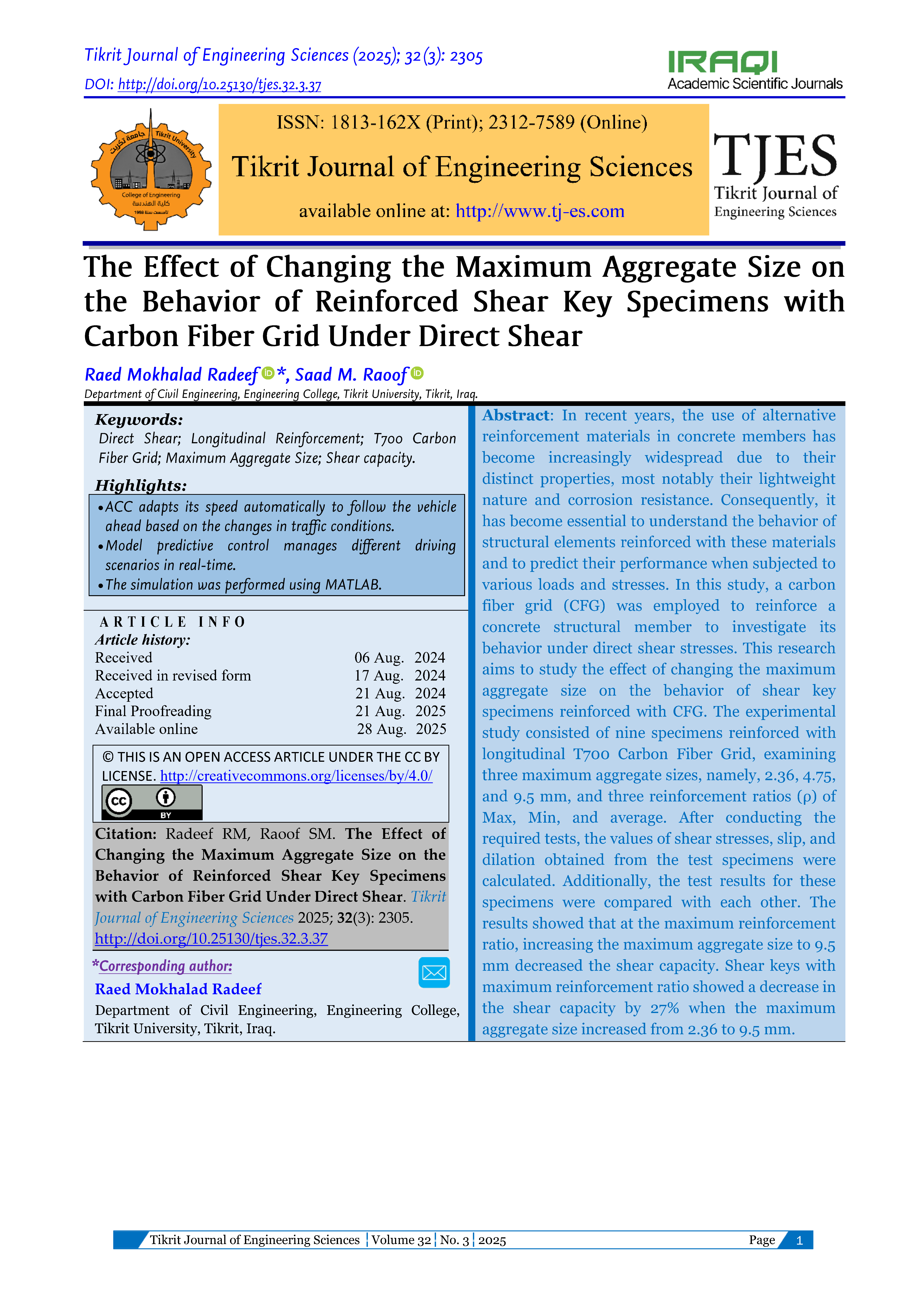The Effect of Changing the Maximum Aggregate Size on the Behavior of Reinforced Shear Key Specimens with Carbon Fiber Grid Under Direct Shear
محتوى المقالة الرئيسي
الملخص
In recent years, the use of alternative reinforcement materials in concrete members has become increasingly widespread due to their distinct properties, most notably their lightweight nature and corrosion resistance. Consequently, it has become essential to understand the behavior of structural elements reinforced with these materials and to predict their performance when subjected to various loads and stresses. In this study, a carbon fiber grid (CFG) was employed to reinforce a concrete structural member to investigate its behavior under direct shear stresses. This research aims to study the effect of changing the maximum aggregate size on the behavior of shear key specimens reinforced with CFG. The experimental study consisted of nine specimens reinforced with longitudinal T700 Carbon Fiber Grid, examining three maximum aggregate sizes, namely, 2.36, 4.75, and 9.5 mm, and three reinforcement ratios (ρ) of Max, Min, and average. After conducting the required tests, the values of shear stresses, slip, and dilation obtained from the test specimens were calculated. Additionally, the test results for these specimens were compared with each other. The results showed that at the maximum reinforcement ratio, increasing the maximum aggregate size to 9.5 mm decreased the shear capacity. Shear keys with maximum reinforcement ratio showed a decrease in the shear capacity by 27% when the maximum aggregate size increased from 2.36 to 9.5 mm.
المقاييس
تفاصيل المقالة

هذا العمل مرخص بموجب Creative Commons Attribution 4.0 International License.
THIS IS AN OPEN ACCESS ARTICLE UNDER THE CC BY LICENSE http://creativecommons.org/licenses/by/4.0/
##plugins.generic.plaudit.displayName##
المراجع
American Concrete Institute (ACI). Design and Construction Guide of Externally Bonded FRCM System for Concrete and Masonry Repair and Strengthening (ACI 549). American Concrete Institute; 2019.
Wermager SL. Shear-Friction of Sand-Lightweight Clay and Slate Aggregate Concretes with Varied Reinforcement Ratios. Master's Thesis, University of Nebraska-Lincoln; 2015.
Paulay T, Park R, Phillips MH. Horizontal Construction Joints in Cast-in-Place Reinforced Concrete. American Concrete Institute, ACI Special Publication 1974; SP-042: 599–616.
Khayat KH, Feys D. Design, Production and Placement of Self-Consolidating Concrete. RILEM Bookseries 2010; 1: 429–438. DOI: https://doi.org/10.1007/978-90-481-9664-7
Shariatmadar H, Khatamirad M, Zamani E. Pre-Cracked Concrete Shear Strengthened with External CFRP Strips. Journal of Rehabilitation in Civil Engineering 2013; 1(1): 29–38.
Al-Shathr BS, Al-Attar TS, Hasan ZA. Effect of Curing System on Metakaolin Based Geopolymer Concrete. Journal of Babylon University 2016; 24(3): 569-576.
Al-Quraishi H, Lafta MJ, Abdulridha AA. Direct Shear Behavior of Fiber Reinforced Concrete Elements. Journal of Engineering 2018; 24(1): 231–248. DOI: https://doi.org/10.31026/j.eng.2018.01.16
Birkeland PW, Birkeland HW. Connections in Precast Concrete Construction. ACI Journal Proceedings 1966; 63(3): 345-368. DOI: https://doi.org/10.14359/7627
Iraqi Specification No. 5. Portland Cement. Central Agency for Standardization and Quality Control, Planning Council, Baghdad, Iraq; 1984.
Iraqi Specification No. 45. Aggregate from Natural Sources for Concrete and Construction. Central Agency for Standardization and Quality Control, Planning Council, Baghdad, Iraq; 1984.
Salih YA, Al-Salman HA, Jomaa’h MM, Abdulla AI. Flexural Behavior of Reinforced Concrete Voided Slabs Strengthened with Different Types of FRP: State-of-the-Art Review. Tikrit Journal of Engineering Sciences 2023; 30(3): 124-139. DOI: https://doi.org/10.25130/tjes.30.3.13





